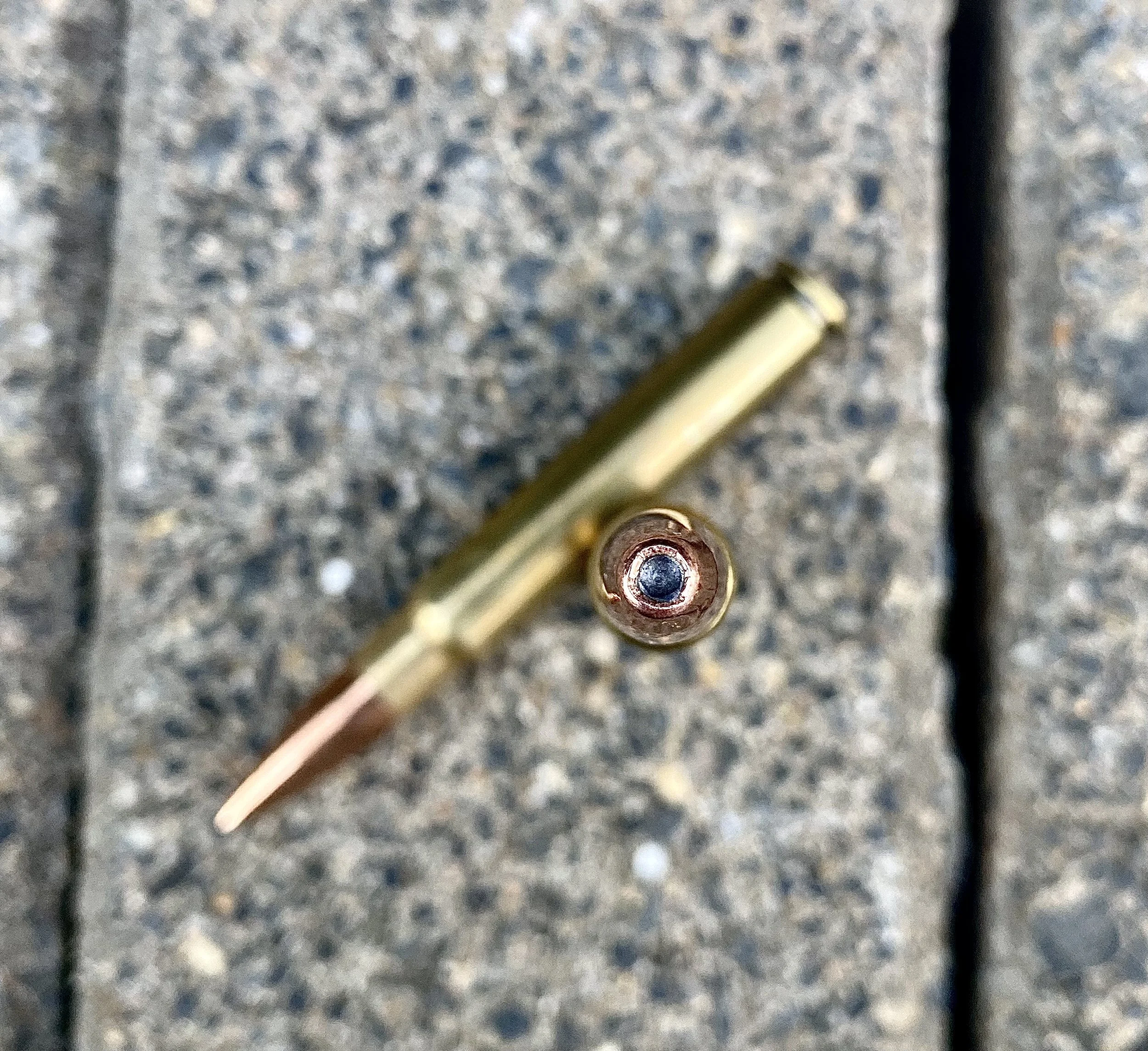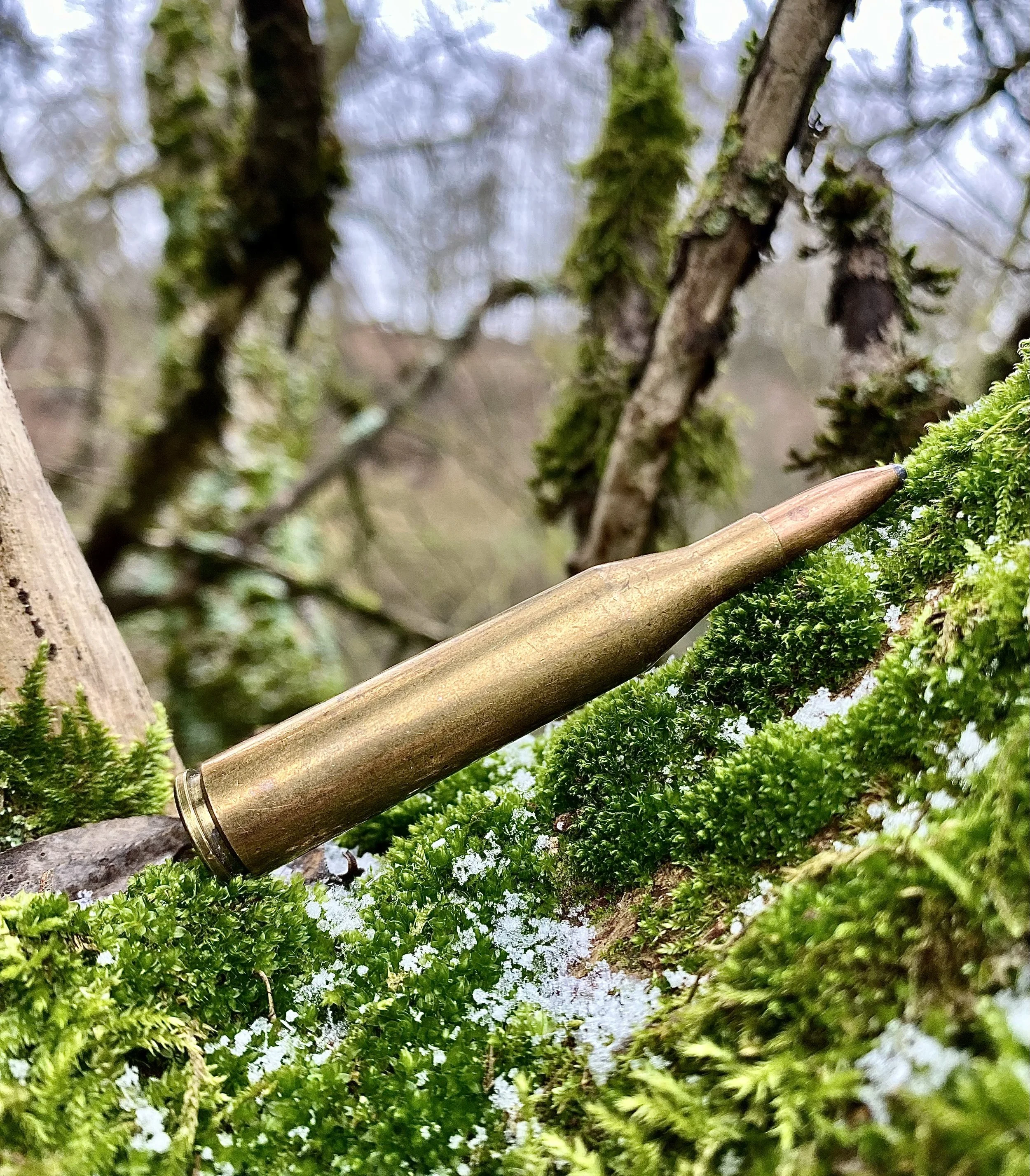Optimum Game Weight Formula 308 Winchester
Image shows 7mm-08 and 308 cartridges being assessd via the Optimum Game Weight formula.
Does the Optimum Game Weight formula favor the 308 Winchester over the 7mm-08 Remington? Does the Optimum Game Weight formula actually work for determining a suitable hunting cartridge? A reader, Bruce, recently asked what I thought about this. Bruce was, wisely, comparing performance of his and his wife's 7mm-08 Rem. and 308 Win. rifles. Below I expand on a quick letter I sent the gentleman. After reading it, perhaps you'd care to weigh in with your ideas, too? We might all benefit from collective intelligence on the Optimum Game Weight formula.
Ron,
Comparing Winchester Silver ballistic tip 150gr 308 with 140gr 7mm-08, using Winchesters Ballistic calculator out to 600 yards, I find that the 7mm-08 and 308 are ballistic twins. At 600 yds the 308 has 955 lbs, vs 902 lbs.
Bullet drop is within one inch of each other at that range. that's with 225yd zero (25yds zero).
My wife and I shoot both the 7mm-08 in a tikka3 and 308 in a Browning BLR.
To tell the truth they both knock down the Black tail deer we hunt. I cannot tell the difference by pulling the trigger.
I would like to read your take on Optimum Game Weight. This is an area of comparison that seems to be overlooked.
Thank you for your response.
Bruce
Photo shows hunter with trophy Dall sheep ram taken with Optimum Game Weight .284 bullet.
Ballistic Realities of 308 Win. and 7mm-08 Rem. Minimize Optimum Game Weight Differences
Bruce, you are right, or close enough for hunting at all sensible ranges. Technically the 7mm-08, loaded to full potential, will outperform the 308 loaded to full potential for the simple reason each has the same powder capacity (barring any extra-long bullets seated deeply into the powder reservoir.) This means 7mm-08 projectiles of similar weight will enjoy a higher B.C. value. THAT is what makes the biggest difference downrange: conservation of kinetic energy via reduced drag.
My 308 vs. 7mm-08 comparison video and articles were inspired by the crowd of shooters, particularly new ones, who dote on the 308 Win. as some kind of superior long range sniping cartridge. This impression is gleaned from the 308's popularity which is due to its abundance and employment by U.S. and other NATO militaries. Of course the 308 Win/7.62x51 NATO is going to be widely known. The U.S. Army's M21 and newer M24 sniper rifles are chambered 308 Win. Police and SWAT snipers use 308 Win. rifles. When soldiers muster out, thy often choose the familiar 308 for hunting and long range target shooting.
Gun and Ammo Makers Feed the 308 Machine
Gun makers feed the 308 loop by building precise, heavy-barreled target, predator, and even varmint rifles in 308 Win. Ammunition manufacturers compliment this by building high-quality, match-grade 308 ammo as well as cheap plinking fodder and good hunting loads in a wide variety of bullet weights and types. The 308 alliance is hard to beat. Nevertheless...
Image shows 6.5 Creedmoor boxes and cartridges, a round with bettr performance than the 308 Win. that is not measured accurately by the Optimum Game Weight formula.
The 6.5 Creedmoor is rocketing to the top of the charts and is replacing the 7.62 NATO with several branches of our military because it truly is a superior extreme-range round. And that is because of its much higher B.C. bullets fired at the same velocity as the 308. To match B.C. of most 140- to 147-gr. .264 bullets, the 308 would have to shoot 190- to 210- grain bullets. But those weights reduce 308 muzzle velocity to 2600 fps at best. And the recoil is significantly higher. Target shooters don't want or need more recoil for precision shooting. The 6.5 CM simply makes scoring at long range easier. The 7mm-08 offers similar attributes with the advantage of heavier game bullets, but it's never gotten the press ginned up for the 6.5 Creedmoor.
We're not exactly debating how many angels can dance on the head of a pin here, but this is way more nitpicking than a hunter need concern himself with. Nevertheless, match B.C. in all of these at top MVs and the 308 Win. is going to come out on the short end. Not radically short, but short enough to lose a Super Bowl, if you know what I mean.
Optimum Game Weight Formula History, Theory, and Overlooked Variables
Optimum Game Weight formula symbolized on Winchester ammo boxes with animal silhouettes.
Now to your question about Optimum Game Weight: I don't give this theory much credence because terminal bullet performance on game is not a matter of kinetic energy on impact so much as bullet performance on impact, meaning adequate tissue destruction from shock and tissue destruction leading to hemorrhaging. Ed Matunas, an accomplished and trusted gun writer, came up with the Optimum Game Weight formula in the early 1990s. The formula (OGW = V3 * W2 * 1.5 * 10-12 ) arrives at the Optimum Game Weight based on muzzle velocity times bullet weight times the constant of 1.5 times 10-12 . I'm not sure what that constant represents. And I'm concerned that the formula does not take into account bullet shape, construction, and impact velocity. There's a heap of difference between kinetic energy in a round-nose bullet at 10 yards than 300 yards. And expansion is wildly different with most bullets at 1,600 fps and 3,000 fps. And a Nosler E-Tip isn't the same as a Federal Fusion, etc. Too many variables have been left out of the OGW formula.
Broadhead Benchmark Challenges Optimum Game Weight Validity
When considering cartridge/bullet performance (and it's really just bullet performance, the cartridge merely holding the powder to create the MV,) I use an arrow/broadhead as a benchmark. We could use a 40-grain 22 Long Rifle, too. If a puny little arrow carrying less than 100 f-p energy can kill deer, elk, bears, buffalo and even elephants, what value is so-called knockdown energy or OGW formula? If knockdown energy really did what it implies, the 3,000-plus f-p energy in a 180-grain bullet from a 300 Win Mag should lift a 200-pound whitetail 15 feet into the air — or at least shove it back ten to 15 feet, no? (One f-p energy is enough to lift a mass of one-pound a foot off the ground.) Yet I've shot such deer (coyotes too) with said bullet without knocking them down or even slightly sideways WITH the bullet staying INSIDE the carcass (full absorption of the energy.) They just take the hit, run, and expire in a few seconds because of blood loss. In my considerable experience you have to step down to game the size of a jackrabbit or ground hog to see bullet impact energy move the body significantly -- even when the bullet stays inside and the animal absorbs all the kinetic energy.
In support of maximizing hemorrhaging to improve terminal performance, I reference many, many dramatic kills with 55- to 75-grain bullets fired from high velocity 22-250 Rem., 220 Swift, 243 Win, 6mm Rem, etc. rifles. I've seen heart/lung hits with these drop 30- to 250-pound game so quickly and dramatically that observers shouted in amazement. How does this happen? Quickly fragmenting bullets at high velocity create massive hemorrhaging quickly. Blood pressure drops so fast that the animal quickly faints, then expires as brain cells die.
Optimum Game Weight Formula Just Common Sense
In conclusion, I do not think the OGW formula fails in practice. It strikes me as overly broad, but a reasonable balance informed as much by decades of collective experience as by MV and bullet mass. In short, it's just common sense. The 30-06 firing a 180-grain bullet, for instance, is supposed to be adequate for game weighing upwards of 1,100 pounds. And sure enough, it has proven effective on deer, elk, moose, and eland. Surprisingly, however, it's cleanly taken more than its share of buffalo, hippo, and elephant, too.
Optimum Game Weight formula doesn't recommend 30-06 for game as heavy as this eland bull, but it worked anyway.
Bullets, however, can and do fail in practice. I've seen too many good hits with 300-grain bullets carrying in excess of 3,000 f-p energy fail to knock medium-sized game down or even incapacitate it. The OGW was there. The bullet energy was there. The performance was not.
All else being equal (and it never is) a larger bullet carrying more energy will deliver more damage and game terminating performance than a smaller one. That's basic physics. So there is nothing wrong with applying the OGW formula when selecting cartridges. But I don't think it's a big deal. If the right smaller, lighter bullet gets the job done for you and you can shoot it accurately, don't worry about the OGW formula. The formula we really need is one that matches terminal bullet performance to game size.
For more than 50 years Ron Spomer has hunted and taken game from bunnies to buffalo with cartridges from 17 Mach 2 to 458 Lott, rarely chosen based on Optimum Game Weight.


















